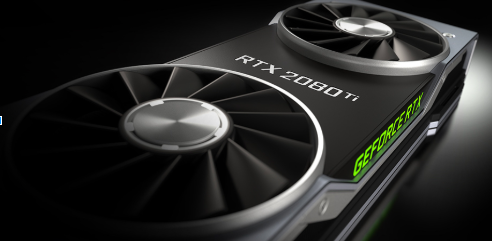NVIDIA’s RTX 20-Series Graphics Processors

Photo Courtesy of The Hive Gaming
RTX 20-Series Graphics Processor
October 9, 2018
A big leap, a jumped gun
Computer enthusiasts, PC gamers, digital media corporations, and perhaps even God Himself seemed to have a ticket to ride the hype train for NVIDIA’s newest round of high-end graphics processors, the Geforce RTX 20-Series. The new line ditched the decade-old GTX title for the new placard, RTX, to signify its emphasis on revolutionary ray-tracing technology. The new units simulated light in 3D environments in an entirely new way from the older models, with brand new processing cores specifically engineered to tackle the problem. Add this groundbreaking tech to an already dominating new graphics rendering architecture, and NVIDIA seemed poised to make a leap and bound forward in terms of computer-generated visuals. Their August 20th keynote, in which the new roundup was announced, showed scenes rendered by the platform which would have given modern graphics supercomputers a challenge – all in a part that can fit into a standard desktop system. So then, NVIDIA’s about to usher in a golden age of consumer graphics, right? Jensen Huang is rolling in cash, and PC gamers everywhere are basking in the glory of visual smoothness and realism matched only by real life, right? Graphical computing was forever revolutionized on the shipping date of Sept. 20, then? Well, no, unfortunately. For all NVIDIA’s honestly amazing leaps forward with their new generation, the biggest jump they’ve taken is over their own gun.
To clarify, the 20-Series, including models 2080 Ti, 2080, and 2070, will be the revolutionary step that everyone hoped it would be. They will deliver butter-smooth visual experiences to computers everywhere, and they will leave any and all competition thoroughly satiated with dust. The biggest problem as of right now is all of those “will”s – the RTX line’s main weapon, its truly incredible ray-tracing light, and shadow rendering is currently all but unavailable. The sold and to-be-sold processors, while technically capable of using the technology, are currently unable to let their horses loose due to a severe dearth of any games or programs which can actually use it. Some titles which will support ray-tracing have been announced, such as Shadow of the Tomb Raider and Battlefield V, but as of yet, they are only able to be played in traditional rendering modes. NVIDIA’s rush to release the RTX line is confusing, then, considering that they are actively working with game developers to bring forth their pedestal technology. Why insist on releasing a product months before anyone can really use it? Perhaps we’ll never know.
Despite its fairly premature launch, the 20-Series is capital-f-far from a failure. In fact, 20-Series models are already proving themselves to be fully dominant even without ray-tracing in benchmarks worldwide. I guess PC enthusiasts who took the early adopter risk will just have to live with 100 frames-per-second at top-notch 4k resolution in all of today’s best games for a few months until ray-tracing technology truly arrives.
